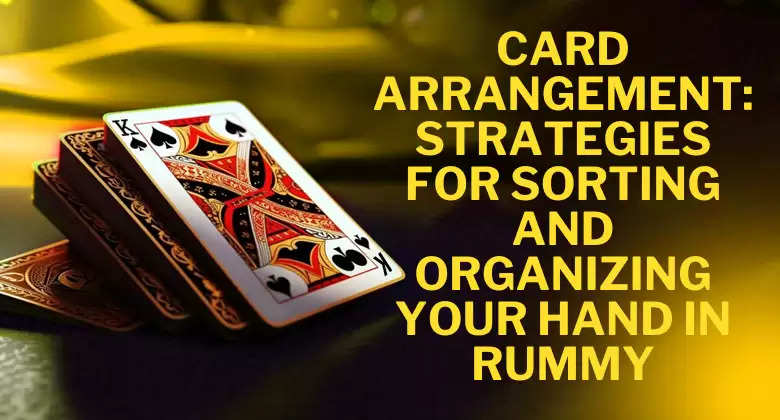Card Arrangement: Strategies for Sorting and Organizing Your Hand in Rummy
The world of rummy is a playground of strategy and skill. While luck plays a role, a crucial factor in success is your ability to effectively sort and organize your cards. Whether you're playing traditional or online rummy, how you organize your hand can significantly impact your gameplay. Let's see the art of card arrangement in rummy, showing you valuable strategies to optimize your hand and maximize your chances of forming winning sets and sequences.
Importance of Card Arrangement in Rummy
In rummy, whether you're playing online on rummy platforms or with friends and family, organizing your cards provides several advantages:
- Faster Melding: Efficient card arrangement allows you to quickly identify potential combinations (sets of three or four cards of the same rank or sequences of three or more consecutive cards of the same suit). It speeds up your gameplay and allows you to see winning opportunities.
- Improved Decision-Making: A well-organized hand gives you a clearer picture of your options. You can make informed decisions about discarding cards with minimal meld potential and prioritize holding onto cards that can create or complete existing melds.
- Reduced Confusion: Playing with a scattered hand can be difficult, especially for beginners. Sorting your cards helps you visualize your hand's composition, reducing confusion and allowing you to focus on strategic plays.
- Psychological Advantage: An organized hand can project confidence to your opponents and influence their decisions and gameplay.
Effective Strategies for Card Arrangement
There's no one-size-fits-all approach to card arrangement in rummy. However, here are some popular sorting systems you can experiment with and adapt to your playing style:
- Group Similar Suits: This method arranges your cards by suit (Spades, Hearts, Diamonds, and Clubs), allowing you to identify potential sequences within each suit quickly. Online rummy platforms offer a convenient sorting feature based on a suit.
- Arrange by Rank: In this method, you organize your cards by rank (from lowest to highest or vice versa). It can help identify potential sets (three or four cards of the same rank) and recognize gaps within them that need filling.
- Color Sorting: You can arrange your cards by alternating colors (red and black). This visual distinction can help players quickly identify melds requiring cards of opposite colors.
- Hybrid Sorting: This approach combines elements of the above methods. It starts by sorting by suit and then organizes cards within each suit by rank for a more detailed picture.
Advanced Sorting Techniques for Rummy
As you get experienced in playing rummy, use these advanced sorting techniques to refine your card arrangement further:
- Prioritizing High-Value Cards: Cards like Ace, King, Queen, and Joker have higher point values in rummy. Organize them first to ensure you use them in the combinations and avoid accidentally discarding them.
- Identifying Meld Building Blocks: Focus on sorting cards that can be easily used in existing or potential melds. For example, prioritize keeping middle-rank cards (like 6s, 7s, and 8s) as they can bridge gaps in sequences.
- Discard Pile Reading: Pay close attention to the cards discarded by your opponents in online rummy. This can give you valuable clues about the combinations they might be making, allowing you to adjust your card arrangement accordingly.
- Keep Jokers Handy: Keep the wild and printed jokers easily accessible in your hand. Jokers can substitute for any other card, making them valuable for completing sequences or sets. You can capitalize on unexpected opportunities and adapt your strategy by keeping jokers handy.
Examples of Effective Card Arrangement in Rummy
Here are some examples showing how card arrangement strategies can be applied in online rummy:
- Scenario 1: You have a hand with 7♦, 8♦, 9♦, 5♠, 6♠, and 10♣. Sorting by suit allows you to see the potential for a sequence in Spades (5♠, 6♠) and focuses your attention on finding a 7♠ or 4♠ to complete it. 7♦, 8♦, 9♦ is already a completed pure sequence.
- Scenario 2: You hold 3♥, 3♣, 3♦, 5♣, 6♣, and J♦. Sorting by rank reveals the possibility of forming a set of threes (3♥, 3♣, 3♦) while also highlighting the potential for a sequence in Clubs (5♣, 6♣) if you can find a 4♣ or 7♣. You can discard J♦ in coming turns.
- Scenario 3: You have A♠, K♦, Q♣, 7♣, 8♣, and J♥. Sorting by rank showcases the lack of immediate sequence potential for these high cards; you could prioritize keeping the 7♣ and 8♣ for a potential sequence in Clubs while looking to discard the high-value cards.
These are just a few examples, and the possibilities are endless. As you play more online rummy, you'll develop your intuition for card arrangement, allowing you to adapt your sorting methods based on the specific cards in your hand and the overall game situation.
Additional Tips for Effective Card Arrangement
Here are some additional tips to keep in mind when arranging your rummy hand:
- Maintain a Consistent System: Once you find a sorting method that works for you, stick with it for consistency. It will help you develop muscle memory and make card arrangement a seamless part of your gameplay.
- Practice Makes Perfect: The more you practice sorting your cards, the faster and more efficient you'll become. Consider playing practice games on online rummy platforms to improve your card arrangement skills in a risk-free environment.
- Adapt to the Game Flow: While maintaining a preferred sorting system is helpful, be flexible and adjust your arrangement based on the cards discarded by your opponents and the melds you're trying to form.
Mastering the Art of Arrangement
Effective card arrangement is a key part of success in rummy. You can significantly enhance your rummy skills by using different sorting techniques, prioritizing meld-building blocks, and adapting your approach based on the game situation.
Ultimately, the best sorting system is the one that feels most intuitive and comfortable for you. Experiment with different methods and find the one that helps you visualize your hand and make strategic decisions most effectively.




